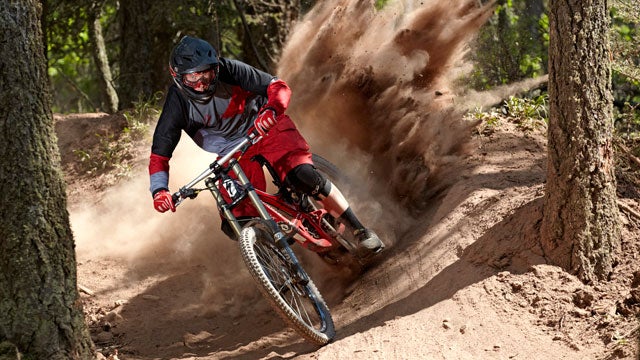Some people may be asking if bikes belong on ski hills. After a late-summer visit to northern New Mexico’s Angel Fire Bike Park, I am here to say—once again—of course they belong. And if you have to ask, you probably haven’t been to a bike park recently.
Angel Fire, a sleepy little resort tucked deep in the Sangre de Cristo mountains of northern New Mexico, has some good winter terrain, but it’s often overshadowed by Taos Ski Valley, the state’s premier winter destination that’s just an hour away. And if it’s neglected in winter, the place becomes all but a ghost town in summer.
At least it used to, back before the . That began to change a decade ago, when the resort was selected to host the 2005 UCI Downhill World Cup. Bike trails already existed here, but the resort constructed a purpose-built DH run for the event, and between the serious and rugged terrain and the 2,000 feet of vertical drop, Angel Fire earned a cult following as one of the best-kept secrets in the West.
As bike technology has made more terrain accessible to a broader audience, Angel Fire, like most parks around the country, has thrived. “If you lived in a place like this in the past, you’d have to find somewhere else to go work in summer,” says Hogan Koesis, director of the Angel Fire Bike Park. “Now we’re seeing 200 and 300 people a day. Double that when we’re busy. The resort isn’t just thinking about skiing. They are building trails and infrastructure to attract people in summer. It’s exploding.”
Much of the growth is coming from a rethinking of what bike park riding means. While many parks started out on steep, technical courses with Whistler-style jumps and wood features, most places, including Angel Fire, have realized that they have to diversify the experience to attract a bigger audience. “We’re always going to have the hard stuff like the World Cup course, but three-quarters of our terrain is now for beginner and intermediate riders,” Koesis says. “Our focus for new building is flow stuff and enduro riding that everyone can enjoy.”
I am no gravity rider—quite the opposite. I mountain bike in spandex, like the long climbs as much as the descents, and have only recently started appreciating bikes with more than four inches of suspension. And yet at Angel Fire, as with every bike park I’ve been to, I never felt over my head because the trails were too difficult or technical.
The I rented from the bike shop, along with the full-face helmet and pads, had something to do with that. It all felt cumbersome and intimidating at first, but as soon as I got out on the trails I found that the slack angles and huge suspension of the bike gobbled up even the hardest terrain.
But what really surprises about these parks is that many of the trails, such as , are smooth, fast, and bermed-out affairs that are more fun than they are challenging. They truly are the biking equivalent of the blue run. Over half the trails I rode at Angel Fire (and I covered the entire mountain in two days) would be perfectly entertaining and safe for the average rider on a five- or six-inch trail bike. I saw numerous families, with middle-age parents down to 8- and 10-year-old kids, all suited up and out rolling down trails together.
So let’s review: Bike parks bring more jobs in mountain towns in the off-season. They increase revenue streams that help free the ski industry from seasonal precipitation fluctuations. The add infrastructure, opportunities, and incentives for people to get out and play. They attract new riders into the bike market. And, at the end of the day, they get more people recreating outdoors. Remind me again why there’s a debate about whether bikes belong at ski resorts?
And don’t even get me going about bikes in


